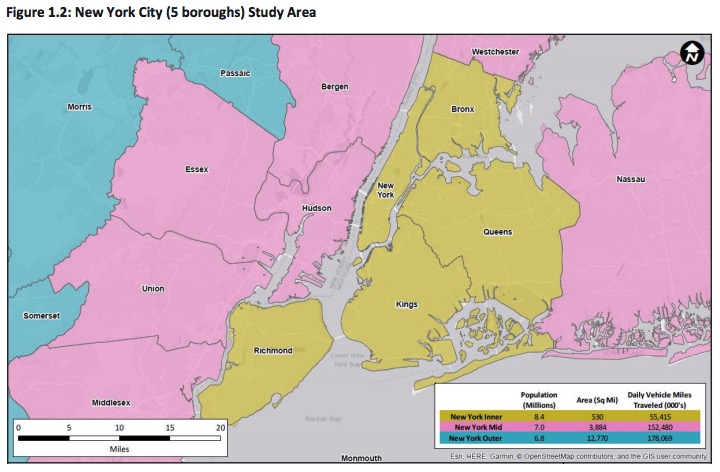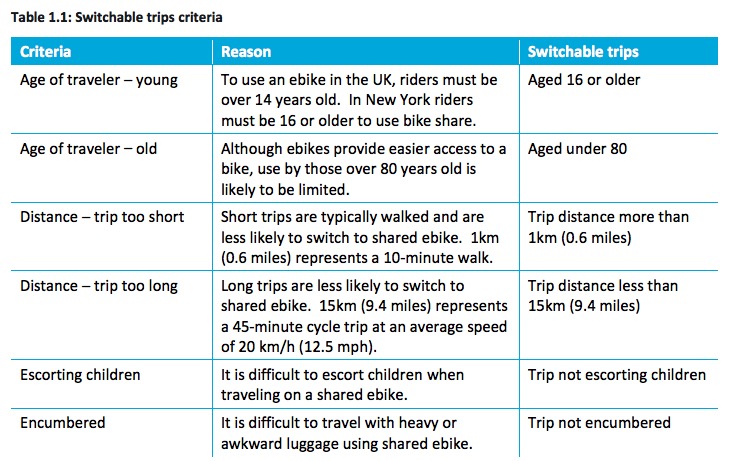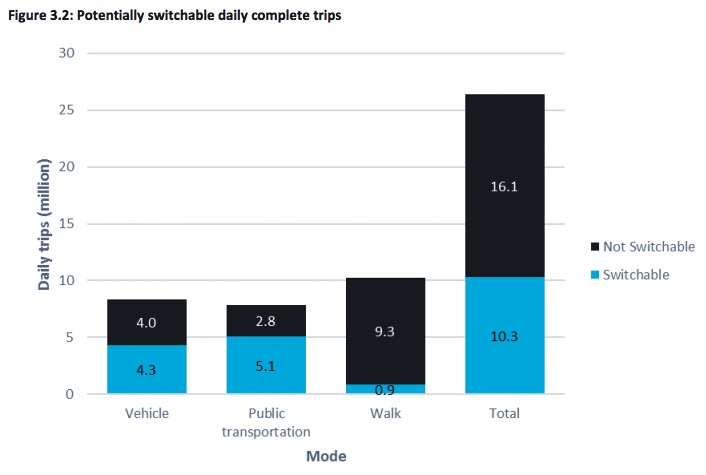STEER GROUP
UBER
Executive Summary
Introduction
Travel in our cities is an ongoing challenge. Every day millions of people compete for space on the road and public transport networks to make journeys to work, to shop, to meet friends, and for many other purposes. Growing populations compound these issues, with London forecast to grow by 2.6 million people by 2041 and New York City forecast to grow by 0.6 million people by 2040.
Cities adapt to these challenges in many ways, from investing in the road and public transport networks, to improving conditions to encourage more people to cycle. New innovations also have a role to play, with publicly and privately-managed bike share systems in London and New York helping to encourage more people to cycle, particularly in inner cities.
Shared ebikes, implemented at scale, offer the potential to switch a significant number of trips from vehicles and also to provide easier access to public transport for the first/last mile access/egress portion of these trips. This would grow the modest number of trips currently served by publicly-managed bike share systems (29,000 per day in London and 47,000 per day in New York) and increase the overall share of trips by bicycle. This report, undertaken by Steer on behalf of Uber presents, for the first time, an analysis of the potential for shared ebikes to revolutionize travel in two case study cities: London and New York.
Analysis Approach
This analysis of switchable trips begins by investigating current trip making patterns to identify the trips that are potentially in scope to switch to shared ebike. An in-scope trip mayor may not switch to shared ebike, however, depending on a number of factors such as the current travel mode and the trip distance. The next step of the analysis therefore quantifies the propensity to switch to shared ebike, given a positive step change in cycle mode share and applies the corresponding switching fractions to the in-scope trips to predict the number of trips that will actually switch.
The analysis considers both complete (end-to-end origin-destination) trips as well as the first/last mile station access/egress portion of trips whose main portion is by public transport.A final step estimates the network-level impacts of the switching to shared ebike in terms of reductions in the number of vehicle trips, and in the accompanying congestion and emissions.
This general approach was applied consistently to analyze the potential demand for and impacts of shared ebikes in London and New York, with some adjustments as needed to adapt to data availability and differences in the two geographies. The analysis can be considered conservative: it does not consider the possibility of new demand being induced by shared ebikes (because they provide greater accessibility and mobility and so encourage new trip making). The analysis also does not explicitly model induced demand for transit, facilitated by more convenient first/last mile access/egress by shared ebike to transit stations. Lastly, the benefits of trip diversions from vehicles to shared ebikes are understated: benefits such as public health improvements are not considered, and estimates of travel delay reductions ignore potential average speed improvements resulting from the diversions.
Shared ebike potential – New York
 Across the 5 boroughs of New York City, of the 26.4 million trips made daily, about 10.3 million trips are potentially switchable to shared ebike based on the criteria noted above.
Across the 5 boroughs of New York City, of the 26.4 million trips made daily, about 10.3 million trips are potentially switchable to shared ebike based on the criteria noted above.
Our analysis suggests that 1 million daily trips in New York City would switch to shared ebike following a deployment at scale. These trips replace 901,000 complete trips previously made by other modes and 97,000 public transportation first/last mile access/egress trips. Based on the volume of trips currently made by New York residents, this would represent a shared ebike mode share of 3.8%, which again is not unrealistic given a positive step change in cycle use consistent with the city’s stated goals. Again, as a comparison, other progressive cities achieve a considerably higher cycle mode share (Copenhagen 29% and Amsterdam 48%.
Between 100,000 to 200,000 shared ebikes would need to be deployed to serve the 1 million daily trips in New York City.
Best Case
If shared ebike adoption in London and New York were to lead to the levels of cycling mode share currently seen in European cities such as Copenhagen, a higher number of trips could be switched to shared ebikes. Following a similar methodology, but assuming that a higher proportion of trips would switch to shared ebikes from their current modes, a ‘best case’ scenario would see 3.2 million daily trips in London switch to shared ebike and 6 million trips in New York City switch to shared ebike.
Introduction
Overview
The purpose of this report is to illustrate the potential demand for and impacts of shared ebikes following a deployment at scale in Greater London and New York. The report considers the effects of shared ebikes in diverting end-to-end origin-destination trips from their vehicles, and also in replacing other modes for the first/last mile access/egress portion of public transport trips. This report, undertaken by Steer on behalf of Uber presents, for the first time, an analysis of the potential for shared ebikes to revolutionize travel in the two case study cities.
This chapter details the study areas of the two cities, the general switchable trips methodology and the data sources used. The report then provides the following detail:
- Chapter 2 – Potential for London trips to switch to shared ebikes, their impact and number of shared ebikes required;
- Chapter 3 – Potential for New York trips to switch to shared ebikes, their impact and number of shared ebikes required; and
- Chapter 4 – Best case: considering European levels of cycling in London and New York.
Study Areas
New York
To facilitate comparisons, we have analyzed both:1) New York City (the 5 boroughs); and 2) the wider New York Metropolitan Transportation Council region (this analysis is presented in Appendix A).
See Figures 1.2 and 1.3 for maps of the New York study area.
The population of New York City (8.4 million) is similar to that of Greater London (8.2 million), and is projected to increase to 9 million by 2040. The 2017 population of the wider NYMTC region is 22.2 million, and is projected to increase to 24.7 million by 2040 .
Switchable trips methodology
Greater London and New York
The methodology has been informed by Transport for London’s switchable trips (to cycling) analysis, with updates to reflect the wider potential appeal of shared ebikes. The analysis starts by considering the total daily trips made by residents of Greater London and New York City. We then apply a succession of filters to the total daily trips to identify the portion of trips that are potentially switchable to shared ebike. We apply the following filters:
Having identified the trips that could potentially switch from their current mode to shared ebike, the analysis next considers the fraction of these that will actually switch, given a deployment of shared ebikes at scale. The probability that a given trip will actually switch depends on:
- trip distance; and
- trip mode.
This analysis takes into account the following data and assumptions:
Shared ebike assumptions
- sufficient shared ebikes are available to meet demand
Current cycling trends and transport policy
- current cycle mode share and trends;
- city ambitions to reduce vehicle (i.e. by car, taxi and other for-hire vehicle) trips and increase public transport, walk and cycle trips; and
- improvements in cycle infrastructure which normalizes cycling for a wider range of people and for more trips, facilitating a greater cycle mode share.
Note that the analysis follows a static approach, in that it does not consider possible induced demand or other second-order or feedback effects of a shared ebike deployment at scale. It starts with existing modal volumes and predicts their diversions to shared ebike, rather than attempting to directly predict modal volumes using a full mode choice modeling approach.
This analysis is based on professional judgement and desk-based analysis. It could be refined and made more rigorous using stated preference research with potential users.
Download full version (PDF): Shared EBike Potential in London and New York
About Steer Group
us.steergroup.com
“We are a global firm spanning 20 offices across four continents working together to make a real difference. Steer grew from humble beginnings and, forty years later, we are a truly international business with global reach, insight and capabilities.”
Tags: Bikeshare, ebikes, London, New York City, shared ebikes, Steer, Steer Group, Uber









 RSS Feed
RSS Feed